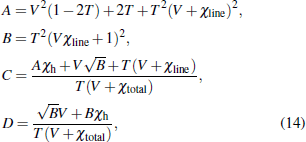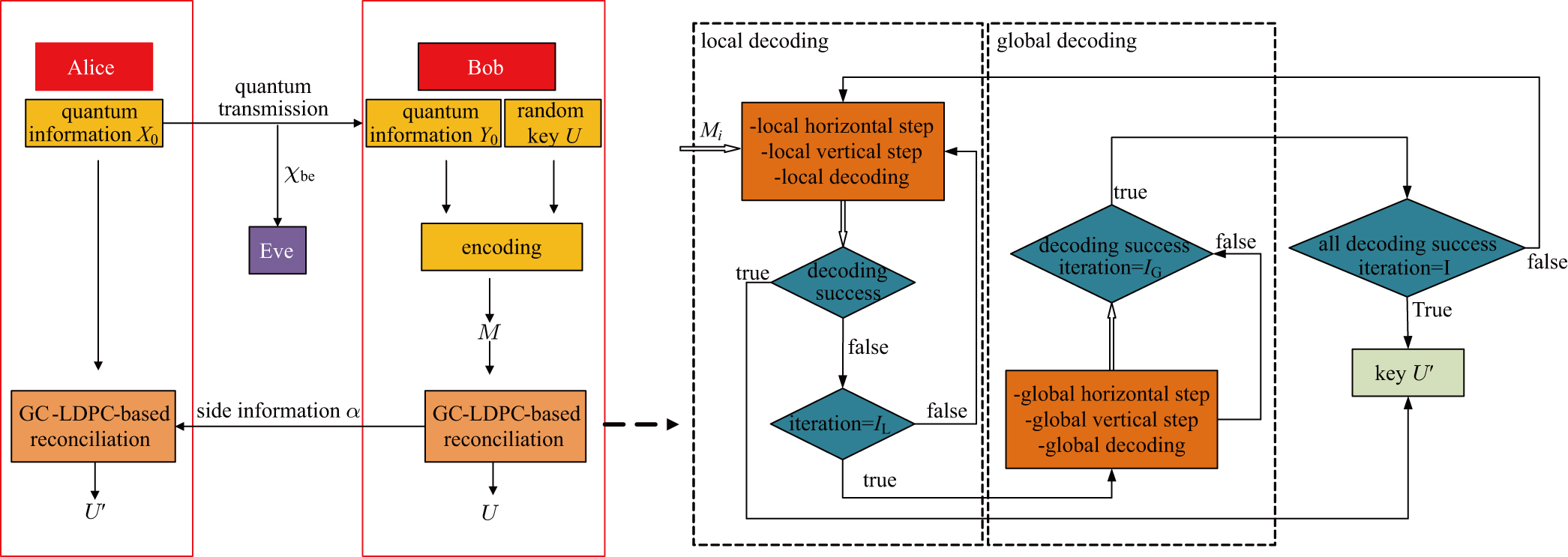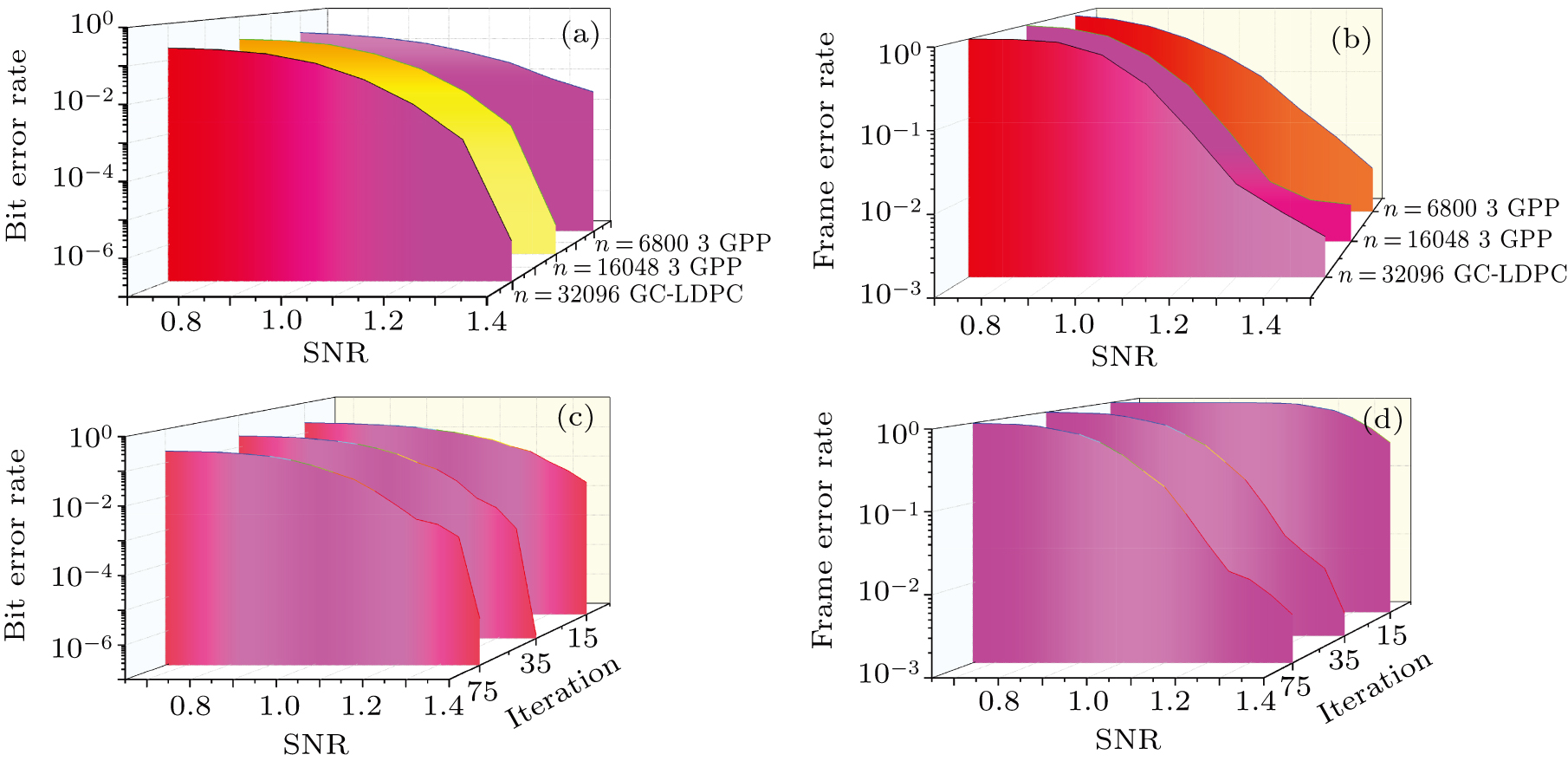† Corresponding author. E-mail:
Project supported by the National Natural Science Foundation of China (Grant Nos. 61801522, 61972418, and 61872390), the Natural Science Foundation of Hunan Province, China (Grant Nos. 2019JJ40352 and 2017JJ3415), and the Special Foundation for Distinguished Young Scientists of Changsha City, China (Grant No. kq1905058).
Reconciliation is a necessary step in postprocessing of continuous-variable quantum key distribution (CV-QKD) system. We use globally coupled low-density parity-check (GC-LDPC) codes in reconciliation to extract a precise secret key from the raw keys over the authenticated classical public channel between two users. GC-LDPC codes have excellent performance over both the additive Gaussian white noise and binary-erasure channels. The reconciliation based on GC-LDPC codes can improve the reconciliation efficiency to 95.42% and reduce the frame error rate to 3.25 × 10–3. Using distillation, the decoding speed can achieve 23.8 Mbits/s and decrease the cost of memory. Given decoding speed and low memory usage, this makes the proposed reconciliation method viable approach for high-speed CV-QKD system.
Quantum key distribution (QKD)[1] system allows two legitimate parties Alice and Bob, linked by a quantum channel and an authenticated classical channel, to share a common random binary key that is unknown to a potential eavesdropper, Eve.[2] The security of QKD is guaranteed by the no-cloning theorem of quantum mechanics. The no-cloning theorem considers that Eve measuring or observing quantum channels would disturb the coherent state which is transmitted from Alice to Bob.[3,4] There have been increased experimental efforts recently in QKD to prove the safety of QKD.[5–7] Continuous variable (CV) and discrete variable (DV) are two major types of QKD system. DV-QKD protocols encode information on the phase or the polarization of single photons.[8] Many schemes are proposed for DV-QKD systems,[9,10] and some of them have been explored to realize long distance and high secure key rate.[11,12] In information reconciliation process, we use low-density parity-check (LDPC) codes to reduce the information which Eve obtains from the honest parties Alice and Bob.[13,14] In CV-QKD system, Alice encodes her information in the amplitude and phase quadrature of coherent states[15,16] and sends it to Bob. On his side, Bob measures the quantum states using homodyne or heterodyne detector.[17,18] The CV-QKD provides a higher repetition rate, which provides a scheme to achieve a higher security key rate.[19]
In CV-QKD, the quantum channel used by Alice and Bob to create secret key is not deemed to be prefect. Noise will make the secret key different between Alice and Bob.[20,21] The information between Alice and Bob, along with the information which Eve gains by monitoring the reconciliation protocol, must then be corrected via post-processing. The post-processing of the CV-QKD system includes the following steps: sifting,[22] parameter estimation,[23,24] information reconciliation,[25] and privacy amplification.[26–29] The post-processing procedure is used to extract final secret key from the obtained raw key,[30] and the information reconciliation is used to correct the errors between Alice’s and Bob’s raw keys by exchanging error correcting messages through an authenticated classical channel.[31] We use LDPC codes to complete information reconciliation in our scheme. There are two types of information reconciliation, i.e., direct reconciliation and reverse reconciliation.[32] Direct reconciliation is that Bob corrects its codeword based on Alice, while reverse reconciliation is that Alice corrects its codeword based on Bob. Due to the safe transmission distance cannot exceed the 3-dB limitation during direct reconciliation, only reverse reconciliation is considered in all safety considerations at this stage.
In order to improve the efficiency of information reconciliation[33,34] for the additive white Gaussian noise channel, we complete reverse reconciliation using check node-based quasi-cyclic globally coupled low-density parity-check (CN-based QC-GC-LDPC) codes which decrease the frame error rate (FER) of CV-QKD. Improving the efficiency can increase the secret key rate. CN-based QC-GC-LDPC codes have a different structure compared to the conventional LDPC block codes and the spatially coupled LDPC (SC-LDPC) codes. Reverse reconciliation[35–37] based on GC-LDPC codes can provide higher reconciliation efficiency than other block codes. After distillation, the decoding speed of reverse reconciliation can reach 23.8 Mbits/s. Through the simulation of our scheme, we obtain the reconciliation efficiency of CN-based QC-GC-LDPC codes can reach 95.42%. Reverse reconciliation using GC-LDPC codes also reduce the FER of CVQKD system, the FER can reach 3.25 × 10–3 and the bit error rate (BER) can be reduced to 5.45 × 10–7. These will make the proposed scheme have high reconciliation performance.
The paper is arranged as follows: In Section
CN-based QC-GC-LDPC codes, which were proposed by Li et al. in Ref. [38], are a special type of LDPC codes with a structure related to but different from that of the SC-LDPC codes. From the perspective of Tanner graph, GC-LDPC codes are composed of a series of disjoint Tanner graphs which are connected together by a group of overall check-nodes (CNs), called global CNs. LDPC codes with this type are called CN-based QC-GC-LDPC codes, which have excellent performance in both the additive white Gaussian noise channel (AWGNC) and the binary erasure channel (BEC).
CN-based QC-GC-LDPC codes are a kind of quasi-cyclic linear block codes. They are defined by their sparse parity check matrices H = (hij)m×n of size m × n where hij are elements of a binary Galois field GF(2) or non-binary Galois field GF(q) where q > 2. The construction method of CN-based QC-GC-LDPC codes has been introduced in detail in Ref. [39]. Here we briefly introduce the structural characteristics of CN-based QC-GC-LDPC codes. A CN-based QC-GC-LDPC codes are composed of base matrix Bgc which consists of two submatrices as shown:

Denote the parity-check matrix of CN-based QC-GC-LDPC codes as Hqc,gc as shown in Eq. (

Same as other types of LDPC codes, CN-based QC-GC-LDPC codes can also be represented by Tanner graphs as shown in Fig.
In CV-QKD system, Alice transmits N quantum coherent states to Bob through a quantum channel,[42] i.e., y0 = t × x0 + z, where 

As shown in Fig.
We mentioned the BP algorithm in Subsection 


In the BP decoding algorithm, the quantities of non-zero elements in check nodes (CNs) and variable nodes (VNs) are constantly updated during the iteration. The operations of message passing can be described as follows:[48]

In the horizontal step, we calculate message L(rji) of each CN which passed from CNs to VNs. This step is used to update message of CNs.

We depict the CN decoder situation in Fig.
 | Fig. 3. Figure of the horizontal step. The message Lrji is calculated based on information from all of its variable nodes, excluding message from VNi, and message L(rji) is sent to VNi. |
In this step, we calculate message L(qij) of each VN which passed from VNs to CNs. In Fig.

 | Fig. 4. This figure shows the vertical step. The message L(qij) is calculated based on information from all of its check nodes, excluding message from CNj, and message L(qij) is sent to CNj. |

In this section, we will introduce the performance of reverse reconciliation based on CN-based QC-GC-LDPC codes. There are some indicators that can reflect the performance of the reverse reconciliation, such as bit error rate, frame error rate, decoding speed, and reconciliation efficiency β.
In order to achieve high speed of the reverse reconciliation, it is necessary to analyze the factors which affect the reconciliation speed. Some factors will affect the reconciliation speed in different aspects, such as the decoding algorithm. The decoding algorithm is the most important factor affecting the reconciliation speed, and it is also the most important step of the reverse reconciliation. We use the BP algorithm to complete the reverse reconciliation. We apply the check matrix Hqc,gc in the BP algorithm and the sparsity and irregularity of the check matrix bring the difficulty in calculation and decoding.
Considering the sparsity of the check matrix Hgc,qc, we apply “distillation” to reduce the complexity of the operation about the error correction.[4] Since the decoding process of BP algorithm is related to the column and row position of element 1 in Hqc,gc, we transform the sparse check matrix Hqc,gc into two one-dimensional matrices, which contain the column and row positions of elements 1 in the Hqc,gc matrix. For a clear expression, we use an example to illustrate the process of the matrix transformation. Assume that the matrix H is shown below

After the process of “distillation”, we use one-dimensional vector row and col to represent the position of elements of 1 in matrix H.

 | Fig. 5. The decoding speed about BP algorithm and BP algorithm using distillation. The decoding speed of BP algorithm using distillation reaches 0.68 Mbits/s in an Intel Core i5-8400 CPU, which is better than BP algorithm. The decoding speed reaches 23.8 Mbits/s in an NVIDIA Tesla K80 GPU. The blue columnar bar represents the decoding speed mentioned in Ref. [4]. |
Thus, using distillation will affect the decoding process, which means that the two-dimensional matrix is involved during decoding. The two-dimensional matrix is characterized by L(rji) and L(qij), respectively. After distillation, the L(rji) and L(qij) introduced in Subsection


We should notice that the range of subscripts i in Eq. (
As described in Subsection 






Although the error correction problem has never been a critical issue for DV-QKD protocol, it only contains a small correction item, error correction is necessary for a CV-QKD protocol. For CV-QKD protocol, Alice and Bob need to extract their mutual information IAB effectively. According to Eq. (


The CN-based QC-GC-LDPC codes are descried in Ref. [40], the code rate is 0.4924 and the SNR Shannon limit is 1.12, using Eq. (
| Table 1. The efficiencies of the reverse reconciliation in the proposed and the previous reconciliation schemes. . |
In this paper, we introduced the reverse reconciliation of CV-QKD system using CN-based QC-GC-LDPC codes. It was shown that the proposed scheme can provide more efficiencies and reduce the BER and FER in the reverse reconciliation. Given high complexity of the sparsity of check matrix in the reverse reconciliation, we use distillation to reduce the computational complexity, and the decoding speed of reconciliation can achieve 23.8 Mbits/s. Low FER and high decoding speed enable the CV-QKD system to quickly complete quantum key distribution. The excellent performance of CN-based QC-GC-LDPC codes can be applied in high-speed CVQKD system.
| [1] | |
| [2] | |
| [3] | |
| [4] | |
| [5] | |
| [6] | |
| [7] | |
| [8] | |
| [9] | |
| [10] | |
| [11] | |
| [12] | |
| [13] | |
| [14] | |
| [15] | |
| [16] | |
| [17] | |
| [18] | |
| [19] | |
| [20] | |
| [21] | |
| [22] | |
| [23] | |
| [24] | |
| [25] | |
| [26] | |
| [27] | |
| [28] | |
| [29] | |
| [30] | |
| [31] | |
| [32] | |
| [33] | |
| [34] | |
| [35] | |
| [36] | |
| [37] | |
| [38] | |
| [39] | |
| [40] | |
| [41] | |
| [42] | |
| [43] | |
| [44] | |
| [45] | |
| [46] | |
| [47] | |
| [48] | |
| [49] | |
| [50] | |
| [51] | |
| [52] | |
| [53] | |
| [54] | |
| [55] | |
| [56] |




